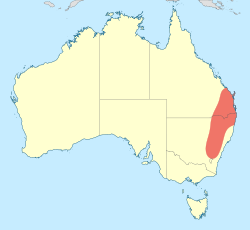| Hemicordulia superba | |
|---|---|
 | |
| Scientific classification | |
| Kingdom: | Animalia |
| Phylum: | Arthropoda |
| Class: | Insecta |
| Order: | Odonata |
| Infraorder: | Anisoptera |
| Family: | Corduliidae |
| Genus: | Hemicordulia |
| Species: | H. superba |
| Binomial name | |
| Hemicordulia superba | |
 | |
Hemicordulia superba is a species of dragonfly in the family Corduliidae, [3] known as the superb emerald. [4] It inhabits rivers, pools and lakes in south-eastern Queensland and northern New South Wales in Australia. [5]
Contents
Hemicordulia superba is a small to medium-sized, black and yellow dragonfly with long legs. In both males and females the inboard edge of the hindwing is rounded. [6]


